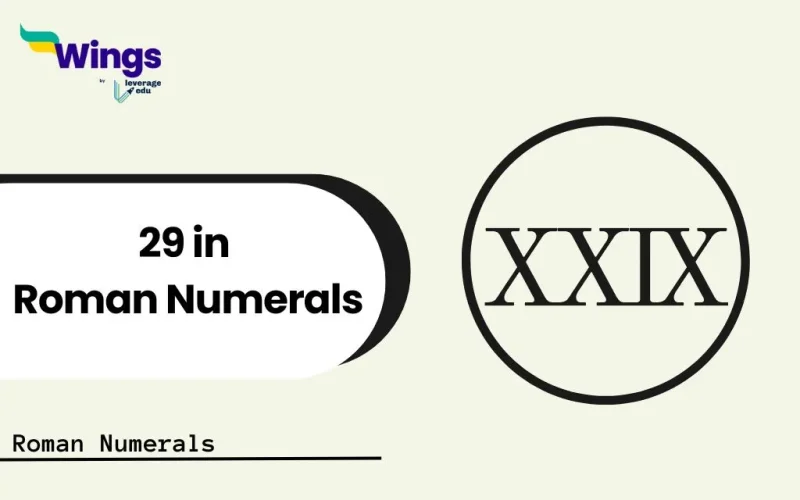Writing 29 in Roman numerals is an interesting exercise once you understand the basic principles. Roman numerals represent numbers using combinations of letters, and 29 is written as XXIX. This is derived by combining the symbols for 20 (XX) and 9 (IX). The number 9 is represented by IX, where I before X indicates subtraction. Roman numerals provide a unique way to express numbers, often seen in clocks, books, and historical contexts. Understanding how to write 29 in Roman numerals helps students appreciate the logic behind ancient numeral systems. Let’s dive into how 29 is represented and why these combinations work.
How to Write 29 in Roman Numerals?
To write 29 in Roman numerals, you use the letters XXIX. The XX represents 20, and IX represents 9. IX is formed by placing I before X, indicating subtraction (10 – 1 = 9). There’s no need for any extra combinations beyond these symbols for 29. This straightforward structure makes Roman numerals an intriguing way to understand numbers, and the representation of 29 is a great example of how they combine simple elements to form larger numbers.
Here are the steps to write 29 in Roman numerals using the Subtraction Rule and Additional Rule:
Step 1: Break Down the Number:
29 = 20 + 9
Step 2: Convert Each Part:
20 = XX (10 + 10)
9 = IX (10 – 1)
Step 3: Combine the Parts:
29 = XX + IX = XXIX
Therefore, 29 in Roman numerals is written as XXIX.
| Number | Roman Numeral |
| 29 | XXIX |
How to Convert XXIX to Number
To convert XX from Roman numerals to a number, you simply need to know the value of the Roman numeral XX, which is 20. Roman numerals are made up of seven symbols (I, V, X, L, C, D, M), and each has a fixed value. In this case, XX represents two X’s, each worth 10, so the total value is 10 + 10 = 20. Understanding how each Roman numeral corresponds to a number helps in easily converting any Roman numeral into its numerical value.
| To convert XXIX from Roman numerals to a number, follow these steps: Break it down: XXIX consists of three parts: XX = 20 (since X = 10 and XX is two X’s) IX = 9 (since I before X indicates subtraction, 10 – 1 = 9) Add them together: 20 (XX) + 9 (IX) = 29 Therefore, XXIX in Roman numerals equals 29. |
Check out a list of Roman numbers from 21 to 30 in the following table:
| 21 in Roman Number | 26 in Roman Number |
| 22 in Roman Number | 27 in Roman Number |
| 23 in Roman Number | 28 in Roman Number |
| 24 in Roman Number | 29 in Roman Number |
| 25 in Roman Number | 30 in Roman Number |
Exercise on 29 in Roman Numerals
Let us practice some questions on Roman Numerals here.
Addition and Subtraction
Add/subtract the following numbers and answer in Roman Numerals
- 50 + 29 = ___
- 100 – 29 = ___
- 129 + 1 = ___
- 250 – 29 = ___
Answers:
- L + XXIX = LXXIX
- C – XXIX = LXXI
- CXXIX + I = CXXX
- CCL – XXIX = CCXXI
Convert to Roman Numerals
Convert the following numbers into Roman numerals:
- 129
- 30
- 27
- 39
Answers:
- 129 = CXXIX
(C = 100, XX = 20, IX = 9) - 30 = XXX
(XXX = 10 + 10 + 10) - 27 = XXVII
(XX = 20, VII = 7) - 39 = XXXIX
(XXX = 30, IX = 9)
Convert to Numbers
Convert the following Roman numerals to numbers:
- XXXIX
- XLIX
- LIX
- LXIX
Answers:
- XXXIX = 39 (XXX = 30, IX = 9)
- XLIX = 49 (XL = 40, IX = 9)
- LIX = 59 (L = 50, IX = 9)
- LXIX = 69 (LX = 60, IX = 9)
Match the Following
Match the following numbers to Roman numerals:
| Numbers | Roman Numerals |
| (i) 149 | (a) CCXXIX |
| (ii) 229 | (b) XCIX |
| (iii) 99 | (c ) CXLIX |
| (iv) 39 | (d) XXXIX |
Answers:
(i) 149 = (c) CXLIX
(ii) 229 = (a) CCXXIX
(iii) 99 = (b) XCIX
(iv) 39 = (d) XXXIX
Check out other Roman Numbers here:
| 11 in Roman Numerals | 31 in Roman Numerals |
| 12 in Roman Numerals | 32 in Roman Numerals |
| 13 in Roman Numerals | 33 in Roman Numerals |
| 14 in Roman Numerals | 34 in Roman Numerals |
| 15 in Roman Numerals | 35 in Roman Numerals |
| 16 in Roman Numerals | 36 in Roman Numerals |
| 17 in Roman Numerals | 37 in Roman Numerals |
| 18 in Roman Numerals | 38 in Roman Numerals |
| 19 in Roman Numerals | 39 in Roman Numerals |
| 20 in Roman Numerals | 40 in Roman Numerals |
FAQs
Ans: XXIX = 29
Ans: 20 in Roman numeral is XX.
Ans: X = 10
Ans: 9 = IX
Ans: 30 = XX
Ans: Roman numerals are a system of numerical notation used by the ancient Romans. They use a combination of letters from the Latin alphabet to represent numbers.
Ans: Roman numerals originated in ancient Rome.
Ans: They were used throughout the Roman Empire and continued to be used in Europe for centuries, even after the fall of the Roman Empire.
Ans: Here are some common uses of Roman numbers:
Practical purposes: For everyday calculations, record-keeping, and commerce.
Symbolic purposes: To represent dates on monuments, in books, and for artistic expression.
Ans:
I = 1
V = 5
X = 10
L = 50
C = 100
D = 500
M = 1000
Ans:
Addition: Numbers are typically formed by adding the values of the symbols together (e.g., III = 1 + 1 + 1 = 3).
Subtraction: When a smaller numeral is placed before a larger one, it indicates subtraction (e.g., IV = 5 – 1 = 4).
Ans: Yes, in limited contexts:
Clock faces: Often seen on traditional clocks.
Book and movie sequels: (e.g., “Star Wars Episode IV: A New Hope”)
Outlines and numbered lists: Sometimes used for stylistic purposes.
Copyright dates: Occasionally used on older materials.
Ans: Here are the limitations of the Roman number system:
Complexity for large numbers: Representing very large numbers can become cumbersome.
Lack of a zero: Makes certain calculations and mathematical operations more difficult.
Ans: Yes, there have been minor variations in the way Roman numerals were written and used throughout history.
Ans: The development of the Hindu-Arabic numeral system (the system we use today), which is more efficient for complex calculations, gradually replaced the use of Roman numerals in most contexts.
For more blogs on school education, follow Leverage Edu now.
 One app for all your study abroad needs
One app for all your study abroad needs














